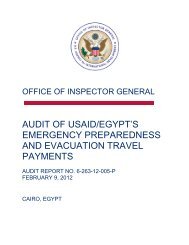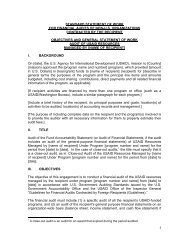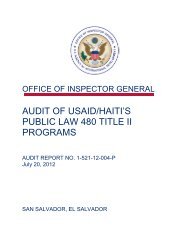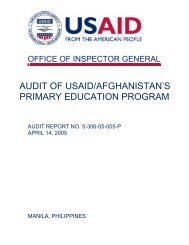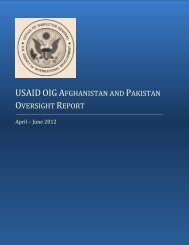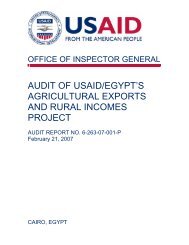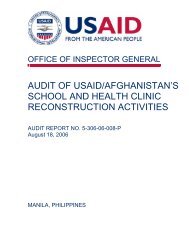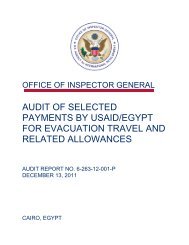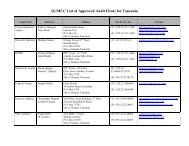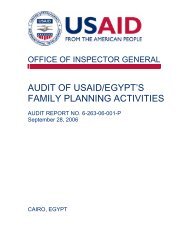Audit of USAID's Haiti Recovery Initiative Activities MAnaged by ...
Audit of USAID's Haiti Recovery Initiative Activities MAnaged by ...
Audit of USAID's Haiti Recovery Initiative Activities MAnaged by ...
Create successful ePaper yourself
Turn your PDF publications into a flip-book with our unique Google optimized e-Paper software.
OFFICE OF INSPECTOR GENERALAUDIT OF USAID’S HAITIRECOVERY INITIATIVEACTIVITIES MANAGED BYOFFICE OF TRANSITIONINITIATIVESAUDIT REPORT NO. 1-521-12-009-PSEPTEMBER 26, 2012SAN SALVADOR, EL SALVADOR
Office <strong>of</strong> Inspector GeneralSeptember 26, 2012MEMORANDUMTO:FROM:SUBJECT:USAID/DCHA/OTI Director, Robert JenkinsUSAID/<strong>Haiti</strong> Acting Mission Director, Herbert SmithRegional Inspector General/San Salvador, Jon Chasson /s/<strong>Audit</strong> <strong>of</strong> USAID’s <strong>Haiti</strong> <strong>Recovery</strong> <strong>Initiative</strong> <strong>Activities</strong> Managed <strong>by</strong> the Office <strong>of</strong>Transition <strong>Initiative</strong>s (Report No. 1-521-12-009-P)This memorandum transmits our final report on the subject audit. In finalizing the report, weconsidered your comments on the draft report and have included those comments in theirentirety in Appendix II <strong>of</strong> this report.The report includes eight recommendations to help the Office <strong>of</strong> Transition <strong>Initiative</strong>s (OTI) inimproving program implementation. Based on your written comments in response to the draftreport, management decisions have been reached on all eight recommendations. In addition,final action has been taken on Recommendations 2, 4, 5, 6, 7, and 8. Please provide the <strong>Audit</strong>Performance and Compliance Division <strong>of</strong> USAID’s Office <strong>of</strong> the Chief Financial Officer withevidence <strong>of</strong> final action on Recommendations 1 and 3.I want to thank you and your staff for the cooperation and courtesies extended to us during thisaudit.U.S. Agency for International DevelopmentEmbajada AmericanaUrb. y Blvd Santa ElenaAntiguo Cuscatlan, Depto. La LibertadSan Salvador, El Salvadorwww.usaid.gov/oig
While these meetings contribute to program development and implementation, they do notmeasure progress toward ultimate program goals.HRI-II Did Not Have Program-Wide Monitoring and Evaluation Plan. When the programstarted in March 2011, the staff developed a monitoring and evaluation guide that consisted <strong>of</strong>guidelines and procedures for developing monitoring and evaluation plans. However, it did notconstitute a formal plan that HRI-II’s staff could use to track progress, nor did it explain howresults would be measured and documented throughout the program.Chemonics <strong>of</strong>ficials said they decided not to prepare a formal plan because the activities wereso different from each other that monitoring and evaluation plans needed to be tailored to theactivity level. At the time <strong>of</strong> the audit, HRI-II had 141 activities in progress. Because eachactivity had its own individual monitoring and evaluation plan, Chemonics was tracking141 different plans, but had no single plan for the entire program. After an activity wascompleted, the Chemonics staff performed a final evaluation. OTI and Chemonics <strong>of</strong>ficials saidthey would use final evaluations, comparisons <strong>of</strong> “clusters” <strong>of</strong> similar activities, and “thematicreviews to provide lessons learned and a feedback loop” to guide future activities.However, given HRI-II’s short time frame and the different nature <strong>of</strong> the activities, this approachmight not provide useful or timely information as a monitoring and evaluation tool.Poorly Defined Indicators. USAID guidance states that performance indicators should beunambiguous about what is being measured and closely track the results they are intended tomeasure.Some <strong>of</strong> the performance indicators Chemonics developed were not well-defined. One activityprovided computer equipment, chalkboards, benches, chairs, desks, and school kits consisting<strong>of</strong> backpacks and school supplies to two public schools in target communities. Yet aperformance indicator for that activity measured the number <strong>of</strong> students who returned to school.OTI developed the activity to help <strong>of</strong>fset some <strong>of</strong> the costs borne <strong>by</strong> the parents in sending theirchildren to school, but the performance measure did not correlate to the activity.Other activities reviewed had only one or two indicators, and they were poorly defined; forexample, one purportedly measured Number <strong>of</strong> government institutions supporting a conflictand/or fragility. An activity that provided a local municipality with an engineering study forimproving one <strong>of</strong> the town’s main roads was measured <strong>by</strong> Number <strong>of</strong> reconstructed nationalgoverning institutions and systems that receive USG [U.S. Government] assistance toincorporate principles that support democracy and government legitimacy. None <strong>of</strong> theseactivities had indicators that clearly measured objectives.Implementation Plans Lacked Timelines. OTI requires Chemonics to track activity datathrough OTI’s activity database, which includes a field for a detailed implementation plan. Inaddition, an activity or grant notes field provides chronological updates <strong>of</strong> the activity’s progressor anything discussed in implementation meetings. The combined information in the two fieldshelps OTI track an activity’s progress.However, the detailed implementation plans for some <strong>of</strong> the activities reviewed did not haveenough information for OTI to see whether the activity was on track to end on time and to meetits objectives. For example, the plan for providing <strong>Haiti</strong>’s Parliament with temporary <strong>of</strong>fices andmeeting space consisted <strong>of</strong> “The subcontractor will be responsible for the following:4
1) Assembling and installation <strong>of</strong> steel-framed structures; 2) Connection <strong>of</strong> utilities.” No dates orestimated timelines were included.Data Quality Assessments Not Performed. ADS 203.3.7.3 states that performance datareported to USAID/Washington in the performance plan and report must have had a data qualityassessment (DQA) completed within the past 3 years. The goal <strong>of</strong> a DQA is to inform managers<strong>of</strong> data strengths and weaknesses and the extent to which data can be relied upon to influencemanagement decisions.Although results <strong>of</strong> OTI’s HRI-II activities were reported in USAID/<strong>Haiti</strong>’s fiscal year 2011performance plan and report, the staff did not conduct DQAs <strong>of</strong> the data for the five indicatorsthat it reported on in 2011.All <strong>of</strong> the problems discussed in this finding stemmed from the fact that OTI did not makemonitoring and evaluation a priority early in the HRI-II’s implementation. OTI <strong>of</strong>ficials said itstarted becoming a priority when Chemonics hired a full-time monitoring and evaluation <strong>of</strong>ficerin August 2011.ccording to an OTI management review completed in January 2011, the HRI I program did notplace enough emphasis on monitoring and evaluation. The team conducting the reviewrecommended that OTI hire a permanent staff member to oversee monitoring and evaluation.OTI advertised for a foreign service national monitoring and evaluation specialist in April 2011,but <strong>of</strong>ficials said they did not receive any qualified applicants.Under the program’s monitoring and evaluation framework, it was hard to consistently andeffectively evaluate how results and targets were measured. This handicap could result inactivity objectives not being met. To strengthen the program’s monitoring and evaluationsystem, we make the following recommendations.Recommendation 1. We recommend that USAID/Office <strong>of</strong> Transition <strong>Initiative</strong>simplement a plan to measure and report progress made toward achieving program goalsfor the remainder <strong>of</strong> the program.Recommendation 2. We recommend that USAID/Office <strong>of</strong> Transition <strong>Initiative</strong>s requireChemonics International to update its implementation plans for the remainder <strong>of</strong> theprogram to include estimated timelines for each phase <strong>of</strong> an activity for development,implementation, and closeout.Recommendation 3. We recommend that USAID/Office <strong>of</strong> Transition <strong>Initiative</strong>scoordinate with USAID/<strong>Haiti</strong> to conduct and document results <strong>of</strong> data qualityassessments for the indicators that USAID’s Office <strong>of</strong> Transition <strong>Initiative</strong>s reports on forthe mission’s operational plan and performance report.Communities Were Not InvolvedEnough in <strong>Activities</strong>As described in USAID’s sustainable development strategy, “Sustainable developmentmandates participation. It must involve, respond to, and be accountable to the people who willlive with the results <strong>of</strong> the development effort.” According to the HRI-II contract, the goal <strong>of</strong>USAID/OTI’s efforts in <strong>Haiti</strong> is to help stabilize the country while laying the foundation for5
activities to increase the local population’s awareness <strong>of</strong> the activities and how they willbenefit the community.Short-term Technical AssistanceActivity Did Not Meet ExpectationsThe audit team reviewed one <strong>of</strong> nine ongoing short-term technical assistance activities. Theseprovide an organization with an expert who trains or mentors employees for a short period <strong>of</strong>time. The HRI-II activity provided <strong>Haiti</strong>’s national mapping agency, Centre National del’Information Geo Spatiale (CNIGS) with a geographic information system (GIS) specialist for6 months because the agency lost most <strong>of</strong> its management staff, facilities, and equipmentduring the earthquake. The consultant was responsible for helping transfer mapping informationfrom international humanitarian agencies to CNIGS and for working with other donor agencies indeveloping an information system 1 for coordinating housing and neighborhood reconstruction.According to CNIGS and the consultant, the information system was not finished when hercontract ended in February 2012. CNIGS’s acting director said she did not provide the help theagency needed and her input did not meet its needs. The acting director added that theconsultant’s efforts to document user requirements for the information system were insufficientand would have to be redone <strong>by</strong> the system developer.The consultant said she had difficulties getting CNIGS staff members to discuss data sharingagreements, which delayed establishing the data-sharing protocols. In addition, the tasks <strong>of</strong>implementing the conceptual model <strong>of</strong> the information system and configuring the GIS serverwere only halfway completed <strong>by</strong> the end <strong>of</strong> her contract.The activity did not meet its objectives because Chemonics did not communicate effectively withCNIGs or provide adequate support to the consultant. In October 2011, shortly after theconsultant began working at the agency, she told Chemonics <strong>of</strong>ficials she was having difficultiesdiscussing with CNIGS what they expected her to do in developing the system. Chemonics<strong>of</strong>ficials told her to continue to try to work with the agency.Chemonics <strong>of</strong>ficials said they had separate meetings with the consultant and CNIGS monthly,but they focused on program development. The Chemonics <strong>of</strong>ficials said they never askedagency staff members whether the consultant was meeting their needs and learned only at theactivity’s end that CNIGS was not satisfied with her.Short-term technical assistance might not help grantees if they do not get the type <strong>of</strong> assistancethey need or if they do not use the expertise provided appropriately. To assist OTI in managingcurrent and future short-term technical assistance grants, we make the followingrecommendation.Recommendation 6. We recommend that USAID/Office <strong>of</strong> Transition <strong>Initiative</strong>simplement processes to assess short-term technical assistance with granteesperiodically throughout the grant cycle.1The Housing and Neighborhoods Reconstruction Information System (System d’Information Logementet Quartier/SILQ).7
Environmental Review Not Performedand Approved Before ImplementationADS Chapter 204, “Environmental Procedures,” states that USAID must fully comply withenvironmental procedures established in the Code <strong>of</strong> Federal Regulations (22 CFR 216).USAID is required to “integrate environmental issues into its programs, both to meet U.S.Government legal environmental obligations and to optimize economic and social developmentresults.”Supplementary guidance to ADS 204 provides descriptions <strong>of</strong> environmental procedures toinclude in requests for proposals and award documents. The purpose is to give USAID time toconduct environmental reviews and incorporate environmental factors and mitigating measuresin the design and approval <strong>of</strong> each program and activity before making an irreversiblecommitment <strong>of</strong> resources. ADS further states that the review should be done as early aspossible in the design process to allow enough time for more detailed subsequentenvironmental review and concurrence, and for integrating environmental mitigations into theprocess.Chemonics has established procedures for environmental reviews to screen each activity forpotential adverse impacts, recommend determinations to categorize environmental risk, andidentify mitigation and monitoring measures. The procedures for mitigation and monitoringinclude templates for environmental mitigation plans and reports; these were developed forUSAID/<strong>Haiti</strong> to use when implementing infrastructure and related activities.Several <strong>of</strong> the activities the team reviewed were designated as “negative with conditions,” whichapplies to activities that could have moderate adverse environmental impacts, but could bemanaged effectively with appropriate mitigation and monitoring measures. For these activities,Chemonics used plans that included mitigation measures and reporting on monitoring <strong>of</strong> thosemeasures.In one <strong>of</strong> the activities, OTI did not complete the required environmental review and mitigationand monitoring plan before implementing the activity, which was designed in June 2011 togenerate temporary employment opportunities through planting 700,000 jatropha 2 seedlings inthe Saint-Marc corridor. In Chemonics’s environmental review <strong>of</strong> the activity, it recommended adetermination <strong>of</strong> “negative with conditions,” requiring an environmental mitigation andmonitoring plan.However, although the seedlings were planted in August 2011, OTI had not approved theenvironmental determination, and the mitigation and monitoring plan was not in effect. Theenvironmental <strong>of</strong>ficer visited the jatropha plantation in August 2011 and said that no negativeeffects had occurred; the <strong>of</strong>ficer said Chemonics had done scientific research to be sure that thetype <strong>of</strong> jatropha was proper for the area, but had not yet documented the environmental workperformed. Subsequently, Chemonics developed a mitigation and monitoring plan andsubmitted it to USAID/<strong>Haiti</strong> and OTI for approval. The mission environmental <strong>of</strong>ficer andcontracting <strong>of</strong>ficer’s representative approved the environmental mitigation plan and report inOctober and November 2011, respectively—after the jatropha had already been planted.2Jatropha curcas is a species <strong>of</strong> flowering plant cultivated in tropical and subtropical regions.8
The lack <strong>of</strong> planning for environmental mitigations before implementation happened becauseOTI and Chemonics neglected to be sure that they complied with the requirements to completethe environmental documentation and to obtain the necessary USAID approvals before plantingthe trees. Potentially adverse environmental impacts can occur if proper mitigation andmonitoring procedures are not put into place before implementing an activity and monitoring it.Therefore, we make the following recommendations.Recommendation 7. We recommend that USAID/Office <strong>of</strong> Transition <strong>Initiative</strong>s reviewthe existing environmental documentation <strong>of</strong> current and planned activities forcompliance with environmental review requirements, and document the results <strong>of</strong> thereview.Recommendation 8. We recommend that USAID/Office <strong>of</strong> Transition <strong>Initiative</strong>s requireChemonics to complete environmental reviews before implementing activities.9
EVALUATION OF MANAGEMENTCOMMENTSBased on our evaluation <strong>of</strong> management comments on our draft report, we have determinedthat management decisions have been reached on all recommendations. In addition, finalaction has been taken on Recommendations 2, 4, 5, 6, 7, and 8. Our detailed evaluation <strong>of</strong>management comments follows.Recommendation 1. OTI agreed to implement a plan to measure and report progress towardmeeting program goals for the remainder <strong>of</strong> HRI-II. Officials said they would hire a localcontractor to conduct third-party monitoring and evaluation. In addition, OTI plans to require themonitoring and evaluation contractor to develop indicators to be used for measuring andreporting on goals for the remainder <strong>of</strong> the program. OTI expects to have this in place <strong>by</strong>December 31, 2012. Based on OTI’s planned actions and estimated time frames, amanagement decision has been reached on this recommendation.Recommendation 2. OTI agreed to update its implementation plan for the remainder <strong>of</strong> theprogram to include estimated timelines for each phase <strong>of</strong> an activity for development,implementation, and closeout. In May 2012 OTI updated its procedures and requiredChemonics to submit detailed implementation plans that include timelines for estimatedcompletion <strong>of</strong> each phase <strong>of</strong> an activity. Based on OTI’s response and supporting documentsprovided, final action has been taken on this recommendation.Recommendation 3. OTI agreed to conduct and document DQAs <strong>of</strong> the indicators OTI reportson for the mission’s operational plan and performance report. In management comments, OTI<strong>of</strong>ficials said they would work with USAID/<strong>Haiti</strong>’s Program Office on the DQAs, and they expectto complete them <strong>by</strong> December 1, 2012. Based on OTI’s response and estimated time framesto complete the DQAs, a management decision has been reached on this recommendation.Recommendations 4 and 5. To address the recommendations, OTI issued updated guidanceto Chemonics in August 2012 that required it to incorporate community engagement andcommunication into each activity’s implementation plan. The plans should include informationabout how and when Chemonics plans to engage the communities in an activity and whatcommunication tools it plans to use to increase activity impact <strong>by</strong> highlighting participation <strong>of</strong>local authorities and explaining the benefits to the community. OTI provided a copy <strong>of</strong> theupdated guidance explicitly stating that community engagement is to be conducted in theactivity development stage to promote community ownership and sustainability for allcommunity stabilization activities. As a result <strong>of</strong> OTI’s response and completed actions, finalaction has been taken on these recommendations.Recommendation 6. OTI agreed to implement processes to assess short-term technicalassistance with grantees throughout the grant cycle. In response, OTI has implemented aprocedure to include meetings with grantees as a monitoring and evaluation requirement for itsshort-term technical assistance activities. OTI provided copies <strong>of</strong> the updated monitoring andevaluation guidance issued to Chemonics that includes the new requirement. Based on OTI’sresponse and documented actions, final action has been taken on this recommendation.10
Recommendations 7 and 8. OTI agreed to review the existing environmental documentation<strong>of</strong> current and planned activities for compliance with environmental review requirements, and torequire Chemonics to confirm that environmental reviews are completed before any activitiesbegin. OTI conducted a review <strong>of</strong> current and planned activities for environmental compliance.It also worked with USAID environmental <strong>of</strong>ficials to develop umbrella mitigation and monitoringplans for infrastructure, water and sanitation, and watershed activities. In addition, OTI added astep in its approval process to document environmental compliance requirements that must becompleted before an activity can be approved. OTI provided documentation <strong>of</strong> the newrequirement and a checklist documenting its environmental compliance review <strong>of</strong> the ongoingand planned activities. OTI also provided copies <strong>of</strong> the umbrella environmental mitigation andmonitoring plans. Based on the actions taken <strong>by</strong> OTI and supporting documents, final action hasbeen taken on these recommendations.11
SCOPE AND METHODOLOGYScopeAppendix IRIG/San Salvador conducted this performance audit in accordance with generally acceptedgovernment auditing standards. Those standards require that we plan and perform the audit toobtain sufficient, appropriate evidence to provide a reasonable basis for our findings andconclusions in accordance with our audit objective. We believe that the evidence obtainedprovides that reasonable basis.The purpose <strong>of</strong> the audit was to determine whether OTI is achieving its main goals <strong>of</strong> stabilizing<strong>Haiti</strong> through support for community revitalization, increased citizen engagement, and improvedgovernance.OTI awarded a cost-plus-fixed-fee completion form task order to Chemonics on March 14, 2011,to provide short-term technical assistance to reinforce stability and lay the groundwork forlonger-term development in <strong>Haiti</strong>. As <strong>of</strong> May 3, 2012, OTI had obligated $46.5 million anddisbursed $23 million. As <strong>of</strong> February 10, 2012, OTI had approved activities worth$22.9 million.The audit was performed at USAID/<strong>Haiti</strong> and at the Chemonics project <strong>of</strong>fices in Port-au-Prince,Cap-<strong>Haiti</strong>en, and Saint-Marc from January 11 through April 11, 2012. The audit reviewed ajudgmental sample <strong>of</strong> 22 ongoing and completed activities valued at $6.8 million from a universe<strong>of</strong> 141 activities approved, in process, or completed as <strong>of</strong> February 2012, valued at$22.9 million. The audit covered the period March 14, 2011, through February 10, 2012. Wevisited 19 sites in Port-au-Prince, Cap-<strong>Haiti</strong>en, and Saint-Marc.In planning and performing the audit, we assessed relevant internal controls that OTI used tomanage its <strong>Haiti</strong> program. These controls included established policies and procedures forgrant administration and program management, monitoring and evaluation processes, andreporting processes.MethodologyTo answer the audit objective, we interviewed OTI and USAID/<strong>Haiti</strong> <strong>of</strong>ficials, Chemonicsemployees, grantees, and beneficiaries. We reviewed and analyzed relevant documentsincluding activity plans, grant agreements, grant and procurement documentation, activityprogress and final evaluation reports, and environmental reviews. We judgmentally selected22 ongoing and completed activities to obtain a sample <strong>of</strong> activities across regions, sectors,goals supported, and grantee type. We compared expected results with actual results <strong>by</strong>reviewing supporting documentation, observing activity implementation on site visits, andinterviewing grantees and beneficiaries. Since the testing was based on a judgmental sampleinstead <strong>of</strong> a statistical one, the results and conclusions are limited to the items tested and couldnot be projected to the entire audit universe.To determine the reliability <strong>of</strong> computer-processed data in OTI’s activity database, for activitiesreviewed we compared grant data to source documents, and compared reported progress withconditions we observed during site visits.12
MANAGEMENT COMMENTS Appendix IIAugust 22, 2012MEMORANDUMTO:FROM:SUBJECT:Regional Inspector General/San Salvador, Jon ChassonUSAID/DCHA/OTI Director, Robert Jenkins /s/USAID/<strong>Haiti</strong> Acting Mission Director, Steve Olive /s/USAID Response to <strong>Audit</strong> <strong>of</strong> USAID’s <strong>Haiti</strong> <strong>Recovery</strong> <strong>Initiative</strong> Managed<strong>by</strong> the Office <strong>of</strong> Transition <strong>Initiative</strong>s (Report No. 1-521-12-XXX-P)This memorandum transmits USAID’s response to the Regional Inspector General’sdraft audit report “<strong>Audit</strong> <strong>of</strong> USAID’s <strong>Haiti</strong> <strong>Recovery</strong> <strong>Initiative</strong> Managed <strong>by</strong> the Office <strong>of</strong>Transition <strong>Initiative</strong>s,” dated July 26, 2012 for your consideration.USAID’s Office <strong>of</strong> Transition <strong>Initiative</strong>s (USAID/OTI) programs are, <strong>by</strong> nature,challenging to evaluate because <strong>of</strong> the iterative process applied to project developmentthat is designed to work in rapidly changing program environments such as <strong>Haiti</strong>. Weappreciate the efforts <strong>of</strong> the RIG staff to understand our unique programming approachand processes.Regarding Recommendation 1: We agree with this recommendation. USAID/OTI iscurrently in the process <strong>of</strong> engaging a local contractor to conduct third party monitoringand evaluation. One <strong>of</strong> the first deliverables <strong>of</strong> the contract will be the development <strong>of</strong>indicators that will be used for measuring and reporting against achievement <strong>of</strong> programgoals for the remainder <strong>of</strong> the program. We will have these in place <strong>by</strong> December 31,2012.It should be noted that it is challenging to attribute direct results in complex and fluidstabilization environments, and it is <strong>of</strong>ten the absence <strong>of</strong> destabilizing events thatdemonstrates stability in these historically volatile areas. Barring sudden majordestabilization in our target communities, we anticipate that the indicators will <strong>of</strong>ferqualitative and quantitative impact data and will be based on plausible correlation whichmay not be directly attributable to individual activities.13
Appendix IIRegarding Recommendation 2: We agree with this recommendation. USAID/OTIrevised the “Activity Cycle and Guidebook” on May 2, 2012 to include guidance for thecontractor on improving the implementation plans for each grant. The contractor willnow submit basic implementation plans with the grant approval documentation and willsubmit detailed implementation plans with timelines for estimated completion <strong>of</strong> eachportion <strong>of</strong> the activity no more than one week after the kick <strong>of</strong>f meeting where thegrantee signs the grant.Regarding Recommendation 3: We agree with this recommendation. USAID/OTI willwork with the USAID/<strong>Haiti</strong> Program Office to complete the data quality assessments forthe five indicators to which USAID/OTI contributes in the Mission’s Operation Plan andPerformance Report. We will complete the data quality assessments no later than <strong>by</strong>December 1, 2012.Regarding Recommendation 4 and 5: We agree with this recommendation.Community engagement and ownership is a cornerstone <strong>of</strong> USAID/OTI programsworldwide and an integral part the USAID/OTI program, especially for our communitystabilization activities. This has been an important aspect <strong>of</strong> our approach since theinception <strong>of</strong> the program; however, USAID/OTI recognizes that it has not beenadequately documented and has faced particular challenges in activities that are notdeveloped at the community level but which were requested <strong>by</strong> the <strong>Haiti</strong>an nationalgovernment or other USG actors. USAID/OTI revised the “Activity Cycle andGuidebook” on August 16, 2012, to specify that the contractor will include communityengagement and communication as part <strong>of</strong> the implementation plans for communitystabilization grants. The development section <strong>of</strong> the “Activity Cycle and Guidebook”also now explicitly states that community engagement will be conducted at thedevelopment stage <strong>of</strong> the activity design process to promote community ownership andsustainability for all community stabilization activities. The implementation section <strong>of</strong> the“Activity Cycle and Guidebook” also now states that the contractor submit an activitynote for community stabilization activities describing the communication plan to increasethe local population’s awareness <strong>of</strong> the activity and how it will benefit the community.Regarding Recommendation 6: We agree with this recommendation.Following the site visit <strong>by</strong> the audit team where the unmet expectations were raised <strong>by</strong>the grantee, USAID/OTI discussed the situation with our contractor and immediatelybegan including check-in meetings with the grantee on the M&E plan for Short-TermTechnical Assistance (STTA) activities that were in development. This included twowith the same grantee <strong>of</strong> the audited activity, CNIGS. It should be noted that althoughthere were communication issues with this STTA, for the majority <strong>of</strong> our other STTAactivities to GOH entities, they have asked to extend the consultants because <strong>of</strong> howmuch they value the consultants’ contributions to the organization. USAID/OTI includedgrantee check-ins as an M&E requirement for STTA activities in the August 16, 2012M&E guidebook.Regarding Recommendation 7: We agree with this recommendation.14
Appendix IIThe activities reviewed under this audit were developed prior to Chemonics’ conductingan environmental compliance training in September 2011 in which USAID’s RegionalEnvironmental Officer (REO) and the Mission Environmental Officer (MEO) participated.USAID/OTI has already completed its review <strong>of</strong> environmental documentation forcurrent and planned activities, and worked with the MEO and REO to create threeUmbrella Environmental Mitigation Plans and Reports (UEMPRs) for infrastructure,water and sanitation, and watershed management and irrigation. USAID/OTI createsindividual EMPRs for all HRI activities that do not fall under one <strong>of</strong> the UEMPRs andnow regularly reviews a spreadsheet that tracks the environmental compliance plansand regular reporting for all activities.Regarding Recommendation 8: We agree with this recommendation.On October 20, 2011, HRI added a section in the activity approval documents todocument environmental compliance needs for each activity which must be completedbefore the activity is approved. In this section, the activity is classified based on itspotential for environmental impact and what environmental documentation or mitigationworks will be needed during implementation. Corresponding guidance was added tothe “Activity Cycle and Guidebook” on May 2, 2012. Many <strong>of</strong> the common types <strong>of</strong>activities implemented <strong>by</strong> HRI that have potential for environmental impacts areimplemented using an UEMPR. HRI’s efforts to improve environmental compliancemonitoring were so well-received that HRI was highlighted as an example and an HRIstaff member spoke during the Environmental Compliance (Reg. 216) Workshop hosted<strong>by</strong> USAID/<strong>Haiti</strong> from April 23 - 27.15
U.S. Agency for International Development Office <strong>of</strong> Inspector General 1300 Pennsylvania Avenue, NW Washington, DC 20523 Tel: 202-712-1150 Fax: 202-216-3047 www.usaid.gov/oig



